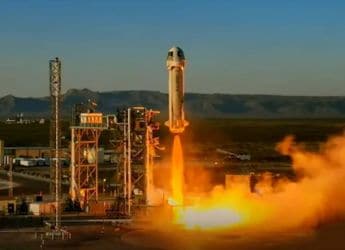- Home
- Science
- Science Features
- Apollo 8: NASA's First Moonshot Was a Bold and Terrifying Improvisation
Apollo 8: NASA's First Moonshot Was a Bold and Terrifying Improvisation

Photo Credit: NASA
Taken aboard Apollo 8, this picture shows Earth peeking out as the spacecraft circumnavigated Moon
Walter Cronkite held a tiny model of the Apollo 8 spacecraft and strode across a darkened studio where two dangling spheres represented Earth and the moon. This was the CBS Evening News, December 20, 1968, and three Apollo 8 astronauts were scheduled to blast off the following morning on a huge Saturn V rocket. Cronkite explained that the astronauts would fly for three days to the vicinity of the moon, fire an engine to slow the spacecraft and enter lunar orbit, circle the moon 10 times, then fire the engine a final time to return to Earth and enter the atmosphere at 25,000 miles per hour.
"They must come in at JUST the right angle. If they come in too steeply, they will be CRUSHED in the Earth's atmosphere. If they come in too shallow, they will SKIP OUT and go into Earth orbit and not be able to return," Cronkite said.
Fifty years later, it's hard to remember how mind-blowing Apollo 8 was, and how scary. No space mission had ever presented so many exotic ways to kill astronauts. Before the launch, a NASA official was overheard imagining what might go wrong: "Just how do we tell Susan Borman, 'Frank is stranded in orbit around the moon'?"
Apollo 8 was the first moonshot. No human being had ever been beyond low Earth orbit. Even the Apollo 8 astronauts - Frank Borman, James Lovell Jr. and Bill Anders - struggled to wrap their heads around what they were about to do.
They shared their final prelaunch lunch with Charles Lindbergh and his wife, Anne Morrow Lindbergh, at Cape Kennedy. "Think, it's hard to believe, this time tomorrow we'll be on our way to the moon," one of the astronauts said, according to Morrow Lindbergh's subsequent article in LIFE magazine.
What's more, Apollo 8 was improvisational. It wasn't even supposed to be a mission to the moon.
"It was an extraordinarily bold decision," says Teasel Muir-Harmony, curator of Apollo Spacecraft at the National Air and Space Museum.
"One of the most risky decisions in the history of spaceflight" is the verdict of historian Asif Siddiqi of Fordham University.
- - -
NASA had a clear goal, established by President John F. Kennedy in 1961, of landing an astronaut on the moon before the end of the decade. The agency carried out a sequence of missions that incrementally advanced its expertise in human spaceflight. Rather than sending astronauts directly from Earth to the moon's surface, NASA's engineers decided that the Apollo program should build a separate lunar lander, which greatly reduced the size of the rocket needed for the mission.
This relatively lightweight vehicle would separate from the command module in lunar orbit and two astronauts would descend to the moon's surface. They would then blast off and dock with the orbiting vehicle. Katherine Johnson, one of the NASA human "computers" made famous decades later by the movie "Hidden Figures," said her greatest contribution to the space program was her calculations for the Apollo program, according to NASA.
By early 1967, the United States appeared to be winning the race to the moon. Then came disaster. During a test of the command module on a launchpad at Cape Kennedy, during which the cabin was filled with pure oxygen, a fire broke out and killed the three Apollo 1 astronauts - Virgil "Gus" Grissom, Roger Chaffee and Ed White.
The tragedy threatened to ruin any chance of putting boots on the moon by the decade's end. By late summer 1968, NASA was desperate to get back on schedule. The refashioned NASA schedule called for Apollo 7 to be an Earth-orbital flight that would test the re-engineered Apollo command module. Apollo 8, the first crewed flight of the Saturn V rocket, would also stay in Earth orbit and test the lunar lander.
But the lunar lander wasn't ready to fly.
Meanwhile, the Soviets were building a giant moon rocket, the N1. The CIA circulated a report in the spring of 1968 saying that the Soviets could potentially send a human being on a mission around the moon before the end of the year. (And in September 1968, a pressurized spacecraft named Zond 5 zoomed around the moon with turtles aboard, clearly a precursor to a human mission.)
George Low, the manager of the Apollo spacecraft program office in Houston, knew that his Apollo schedule was a mess. So he tore it up. He decided Apollo 8 should be a moonshot.
His logic was simple: We have the hardware to fly around the moon. We have the Saturn V rocket, the Apollo command module and the service module. The one missing piece is the lunar lander, and we don't need that for a mission that doesn't try to land.
On Aug. 7, Low presented the idea to Chris Kraft, the director of flight operations in Houston, and asked him to study whether it was technically feasible. On Aug. 9, Low pitched the plan to the head of the Houston centre, Bob Gilruth, who embraced it right away, and Kraft reported that there were no showstoppers. They phoned a number of top NASA officials at other centres and asked them to fly to Huntsville, Alabama, immediately for a 2:30 p.m. meeting. The Apollo program pivoted in a matter of hours.
The top officials at NASA, Administrator James Webb and Associate Administrator for Human Spaceflight George Mueller, were uncomfortable with what appeared to be a mad dash to the moon. Mueller feared "irresponsible scheduling" and the impact on Apollo were there to be a "catastrophic failure," according to Low's private notes. But the Apollo engineers persuaded Webb and Mueller.
The designer of the Saturn V, Wernher von Braun, who as a Nazi scientist had built the V-2 rockets launched against Britain in World War II, also signed on to the plan. According to Low's notes, von Braun said that "it doesn't matter to the launch vehicle how far we go." (As the satirist Tom Lehrer sang: " 'Once the rockets are up, who cares where they come down? That's not my department,' says Wernher von Braun.")
The refashioned Apollo 8 mission required NASA to send the spacecraft on an exquisitely precise trajectory that would enter the moon's gravity well, loop around the far side and come within 60 miles of the surface.
That's where the service module engine would fire, slowing the spaceship. If it didn't fire for some reason, that wouldn't be a disaster, because the trajectory was designed to fling Apollo 8 right back toward Earth, a "free return" courtesy of gravity.
But if the engine burned too long, Apollo 8 could crash on the lunar surface. If it burned too briefly, the spacecraft would neither enter lunar orbit nor return to Earth, but would fly off into the void of space.
The plan called for a second burn, to circularise the remaining orbits. Then would come the most anxiety-inducing burn, the one that would send the spacecraft back to Earth. If that didn't work for some reason, the astronauts would circle the moon until their oxygen ran out. That would take about nine days.
All this would happen over the Christmas holiday.
On the morning of the launch, all eyes were focused on the towering Saturn V. Apollo 8 would be only the third launch of the giant rocket. The first test launch, with no crew, had gone beautifully (Cronkite had roared with glee about the "terrific" launch as the entire observation building shook). But the second launch, also without a crew, had suffered multiple technical failures.
The engineers thought they had fixed the problems for Apollo 8. Now NASA was going to put human beings on top of this rocket that stood 363 feet tall and that had had one successful launch and one not-so-good launch.
Apollo 8 lifted off beautifully. Aerospace engineer James Oberg was watching from the beach nearby. "No TV screen or movie screen can show how bright the flame is. It's like a piece of the sun," he recalled in an interview.
The astronauts were soon in orbit, and just 2½ hours later, Michael Collins, the astronaut in Mission Control assigned to speak with his colleagues in space, said, "Apollo 8, you are go for T.L.I." That meant Trans Lunar Injection. (These people were not poets.) The third stage of the Saturn V ignited, and they were off for the moon.
Frank Borman got sick en route with vomiting and diarrhea. Bill Anders meticulously described how a floating bolus of vomit split apart in zero gravity and confirmed Newtonian physics.
Jim Lovell peered into the eyepieces of the Apollo Guidance and Navigation System, which featured a telescope and a sextant, and navigated by the stars, the moon and the sun, as if a sailor on the high seas. NASA's Deep Space Network tracked the spacecraft with giant radio antennas, and computers in Houston handled calculations.
"How sure are you we're going to miss the moon?" one of the top NASA officials demanded of engineer John Mayer in Houston as Apollo 8 cruised toward its destination. "I'm real sure," he said, laughing, though he had an uneasy afterthought: Why aren't they more worried about a miscalculation at reentry that burns up the spacecraft?
The crew sent back images of Earth, and Earthlings were mesmerized. On CBS, the baritone commentator Eric Sevareid said, "Three creatures of frail flesh and blood are floating through the blackness of space in the neighbourhood of the moon. It is staggering and we do not know what it means."
The spacecraft reached the moon after nearly three days of flight. "See you on the other side," Lovell said just before the spaceship disappeared behind the moon.
People had never seen that side of the moon with their own eyes. Nor had they ever been so cut off from their fellow humans. They had no way to communicate with Mission Control. In Houston, there was nothing to do but wait. The place was silent.
Engineers wandered outside for a smoke.
Then Apollo 8 could be heard again, popping from behind the moon in exactly the right place at the right time. Who said space is hard?
The rest of the mission went splendidly, including that scary final burn, which again happened behind the moon. As the spacecraft came back into contact, on track to return to Earth, Lovell told Houston, "Please be informed, there is a Santa Claus."
The spacecraft splashed into the Pacific just a couple of miles from the Navy aircraft carrier waiting to pick up the astronauts.
On NBC, anchorman David Brinkley said, "The great adventure ended today as it began, with almost everybody in the world holding his breath and hoping it would all work. It all did. It was almost unreasonably perfect. . . . The human race, without many victories lately, had one today. And it will be remembered as long at the human race lasts."
Or at least for seven months. Neil Armstrong and Buzz Aldin walked on the moon the following July. Apollo 8 would thereafter reside in the huge shadow of Apollo 11.
© The Washington Post 2018
Get your daily dose of tech news, reviews, and insights, in under 80 characters on Gadgets 360 Turbo. Connect with fellow tech lovers on our Forum. Follow us on X, Facebook, WhatsApp, Threads and Google News for instant updates. Catch all the action on our YouTube channel.
- Samsung Galaxy Unpacked 2025
- ChatGPT
- Redmi Note 14 Pro+
- iPhone 16
- Apple Vision Pro
- Oneplus 12
- OnePlus Nord CE 3 Lite 5G
- iPhone 13
- Xiaomi 14 Pro
- Oppo Find N3
- Tecno Spark Go (2023)
- Realme V30
- Best Phones Under 25000
- Samsung Galaxy S24 Series
- Cryptocurrency
- iQoo 12
- Samsung Galaxy S24 Ultra
- Giottus
- Samsung Galaxy Z Flip 5
- Apple 'Scary Fast'
- Housefull 5
- GoPro Hero 12 Black Review
- Invincible Season 2
- JioGlass
- HD Ready TV
- Laptop Under 50000
- Smartwatch Under 10000
- Latest Mobile Phones
- Compare Phones
- Huawei Nova 15
- Huawei Nova 15 Pro
- Huawei Nova 15 Ultra
- OnePlus 15R
- Realme Narzo 90x 5G
- Realme Narzo 90 5G
- Vivo S50 Pro Mini
- Vivo S50
- Asus ProArt P16
- MacBook Pro 14-inch (M5, 2025)
- OnePlus Pad Go 2 (5G)
- Infinix Xpad Edge
- OnePlus Watch Lite
- Just Corseca Skywatch Pro
- Acerpure Nitro Z Series 100-inch QLED TV
- Samsung 43 Inch LED Ultra HD (4K) Smart TV (UA43UE81AFULXL)
- Asus ROG Ally
- Nintendo Switch Lite
- Haier 1.6 Ton 5 Star Inverter Split AC (HSU19G-MZAID5BN-INV)
- Haier 1.6 Ton 5 Star Inverter Split AC (HSU19G-MZAIM5BN-INV)


![[Partner Content] OPPO Find X9 Two Week Experience: Here's Why It Stands Out](https://www.gadgets360.com/static/mobile/images/spacer.png)









